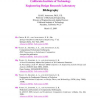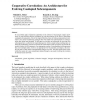98
Voted
TEC
2010
14 years 7 months ago
2010
in HTML. Full version in PDF. 08i YOGEV, O., SHAPIRO, A. A., AND ANTONSSON, E. K. Computational Evolutionary Embryogeny. IEEE Transactions on Evolutionary Computation. Accepted for...
99
Voted
LLC
2010
14 years 7 months ago
2010
Models and concepts from biology have informed the study of language change for several centuries. In this article, I take a comparative look across the disciplines of historical ...
124
click to vote
EC
2000
15 years 17 days ago
2000
In this paper, we provide a systematic comparison of various evolutionary approaches to multiobjective optimization using six carefully chosen test functions. Each test function i...
122
Voted
EC
2000
15 years 17 days ago
2000
To successfully apply evolutionary algorithms to the solution of increasingly complex problems, we must develop effective techniques for evolving solutions in the form of interact...
124
click to vote
CONNECTION
2004
15 years 18 days ago
2004
The Artificial Life approach to Evolutionary Robotics is used as a fundamental framework for the development of a modular neural control of autonomous mobile robots. The applied e...
98
Voted
BMCBI
2005
15 years 19 days ago
2005
Background: Phylogenetic footprinting is the identification of functional regions of DNA by their evolutionary conservation. This is achieved by comparing orthologous regions from...
110
click to vote
BMCBI
2005
15 years 19 days ago
2005
Background: Distance-based methods are popular for reconstructing evolutionary trees thanks to their speed and generality. A number of methods exist for estimating distances from ...
100
click to vote
NAR
2008
15 years 21 days ago
2008
Gene duplication is common in all three domains of life, especially in eukaryotic genomes. The duplicates provide new material for the action of evolutionary forces such as select...
132
click to vote
KES
2008
Springer
15 years 21 days ago
2008
Springer
Evolutionary techniques provide powerful tools to design novel solutions for hard problems in different areas. However, the problem of scale (i.e. how to create a large, complex s...
121
click to vote
EC
2007
15 years 21 days ago
2007
Evolutionary algorithms rarely deal with ontogenetic, non-inherited alteration of genetic information because they are based on a direct genotype-phenotype mapping. In contrast, i...




